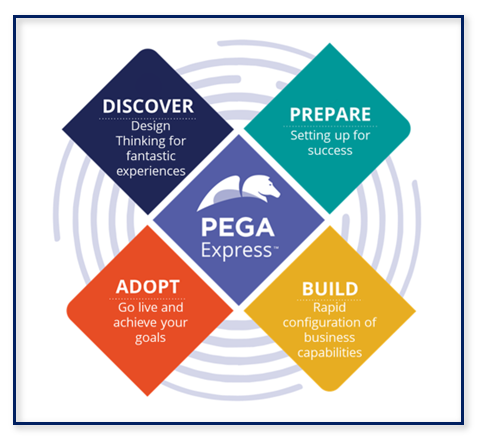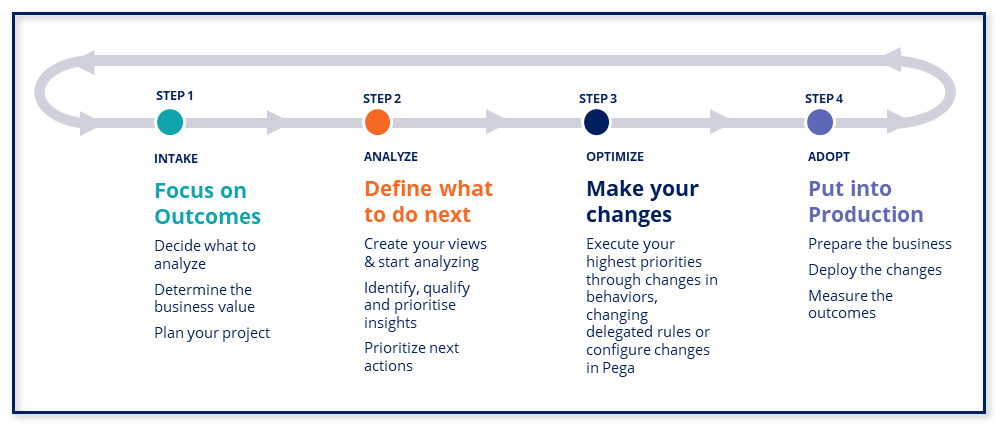Unleashing the Power of Pega Process Mining
There is a lot of excitement following the launch of Pega Process Mining and, in particular, a lot to celebrate because of how it will help our clients to optimize live processes. But let’s take a step back for a few minutes and talk about what Process Mining is, and ask ‘When do we do use it?’ and ‘How do we deliver it?’
Understanding Process Mining
Let’s start with the ‘what.’ At Pega, we use Process Mining to uncover how high-volume live business processes are really performing. How many of us know, truly, how well a process is performing out in the wild? We get reports, sure, and of course we can talk to people about it, and review SLAs and so on to get a reasonable idea. But imagine being able to automatically capture what is happening to a live case in your application whenever something changes, or whenever an action occurs, or what happened to your closed cases. Then scale that to capturing data for thousands and thousands of cases over a couple of weeks, or even months (continuous optimization and monitoring is a good thing!). You can do a LOT with that information. You can analyze the data and the trends, which gives you the insights you need to optimize a process, then you can make changes, and that in turn saves you time, or customers, or cost, or employees, or all of the above! Then you can monitor how those changes have impacted your newly optimized processes, to enjoy the rewards or optimize further.
Process Mining helps us answer questions like ‘How long does a transaction really take from start to finish?’ ‘Are we spending too much time on something that we can automate?’ ‘Are we doing one thing more than another?’ ‘What is slowing us down?’ ‘Where are we sometimes getting stuck?’. In a nutshell, data-driven process management is powerful stuff.
Implementing Process Mining Made Easy with Pega Express
Now that we have covered what it is, let’s talk about when and how we deliver it using Pega Express, our recommended delivery approach. I want to get one thing out of the way early; delivering Process Mining is not complex, nor is it intrusive. You don’t need a big team to deliver it, and it doesn’t have any third-party system dependencies. A single process mining cycle should take between 5 to 10 weeks from start to finish. But before you start, you should have four things in place (plus a license!):
- A live application, so that you can mine the data. If you are approaching go-live or have only just gone live, we recommend allowing enough time for a reasonable volume of cases to have been processed before you start the analysis. This gives you a mix of both closed and in-flight cases to analyze. For example, if a case typically takes a month to go through it’s full lifecycle, you may wish to wait a couple of months. And before you ask, yes, you can analyze closed cases from the past! All the data you need is captured in Pega Platform™ as soon as you switch it on, before you decide which process(es) to analyze.
- A Business Architect: you need someone who has been trained to set up Process Mining and perform the analysis. This can be someone within your existing team or Centre of Excellence who can specialize in Process Mining as an additional skill (they do not need to be solely dedicated to Process Mining). This is a business-focused role; Pega Process Mining is an easy-to-use business tool. The people best suited to this role are certified Pega Business Architects, who can then take the Pega Process Mining Mission on Pega Academy to become Process Mining proficient, and are well placed to collaborate with business owners and create user stories.
- Effective Governance: it may sound obvious, but somebody needs to decide what to optimize and to put in place a process optimization strategy, define priorities, and be accountable for the business case so that the process mining is a viable program. This may fall within your existing governance framework or Centre of Excellence. You need a lightweight intake process to ensure that what you are analyzing aligns with your business outcomes, and a mechanism for sizing the work involved.
- A System Architect or Citizen Developer to implement the configuration changes. Optimization would typically involve changing the configuration of a case type stage or step in some way, so you need the skills to do this. These are not special Process Mining skills; these are skills that come as standard with a Pega-certified System Architect or a Citizen Developer. They can be part of an existing delivery team, part of a Centre of Excellence, or part of a BAU team that maintains your Pega estate.
Once these four things are in place, you’re ready! For those of you familiar with our Pega Express delivery approach, when we lead projects we take a 4-phase cyclical approach of Discover (setup for success), Prepare (get ready to build), Build (configure and test), and Adopt (prepare to go live, go live, plan your next release).
From Insights to Improvements: Driving Change with Process Mining
We go through this cycle for every release and we always start with Discover. However, Process Mining can happen at any time (once you are live!) and fall into line with your delivery cadence.

This is the order of the steps we go through:
- Step 1 – Using your governance framework, you plan the introduction of Process Mining into your delivery approach, including when you will introduce it, and you choose which processes to analyze.
- Step 2 – Your Business Architect configures data views using Pega Process Mining, analyzes the data in your live application, and works with the business to identify opportunities to optimize a process. This is when you transition from understanding the insights, to determining what needs to change.
The insights you gain can lead to different actions:
-
What you learn might result in a change of work routine or behavior, rather than a system change. For example, asking a supervisor to approve or decline a request one at a time rather than in batches.
-
An Insight can lead to changes in a delegated rule, and can be performed by a Manager or supervisor, rather than having to involve the delivery team changing, for example, an SLA
-
You learn that you need to change how the application behaves, and you will need a System Architect or Citizen Developer to make this change. This is when you create a user story and add it to your backlog. By doing this, you are preparing for Build.
-
- Step 3 – As part of your build cycle, whether it’s part of a project or a continuous improvement program, you prioritize any Process Mining optimization user stories as part of your Sprint Planning or regular delivery planning. Once the stories have been prioritized you make the configuration changes as part of your standard build process and then test the changes.
- Step 4 – You’re ready to put your changes into Production! Depending on the changes, you might need to prepare the business for what is changing, explain why the changes are being made (based on the insights gained), and then deploy the changes. You then want to measure the outcomes using Process Mining to see what the impact is.

At the end of this cycle, through your governance framework you can determine if and when you should go through the cycle again. You can decide if you want to continue to monitor and analyze the same process, or different processes. You might decide on a periodic approach, and revisit the same process every 6 months. Process Mining can be a continuous or periodic initiative; there is no finish line, nor should there be, because monitoring application performance is just as important as monitoring application and infrastructure health.
Conclusion
We use Pega Express to deliver Process Mining but, of course, many of our clients and partners have different delivery approaches. By sharing how we do it, you can envisage how Process Mining can fit into your ways of working. Happy mining!
Related Resources
- Pega Process Mining training mission
- Pega Express values and best practices
- Video: Process Mining 101: Continuously Improve and Transform your Pega Workflows with Process Mining
- Video: Achieving Process Excellence with Task Mining and Process Mining at Navy Federal Credit Union
- Blog: How Process Mining tools can take your business where it needs to go
Don't Forget
- JOIN THE CONVERSATION on Support Center
- FOLLOW @PegaDeveloper on Twitter

